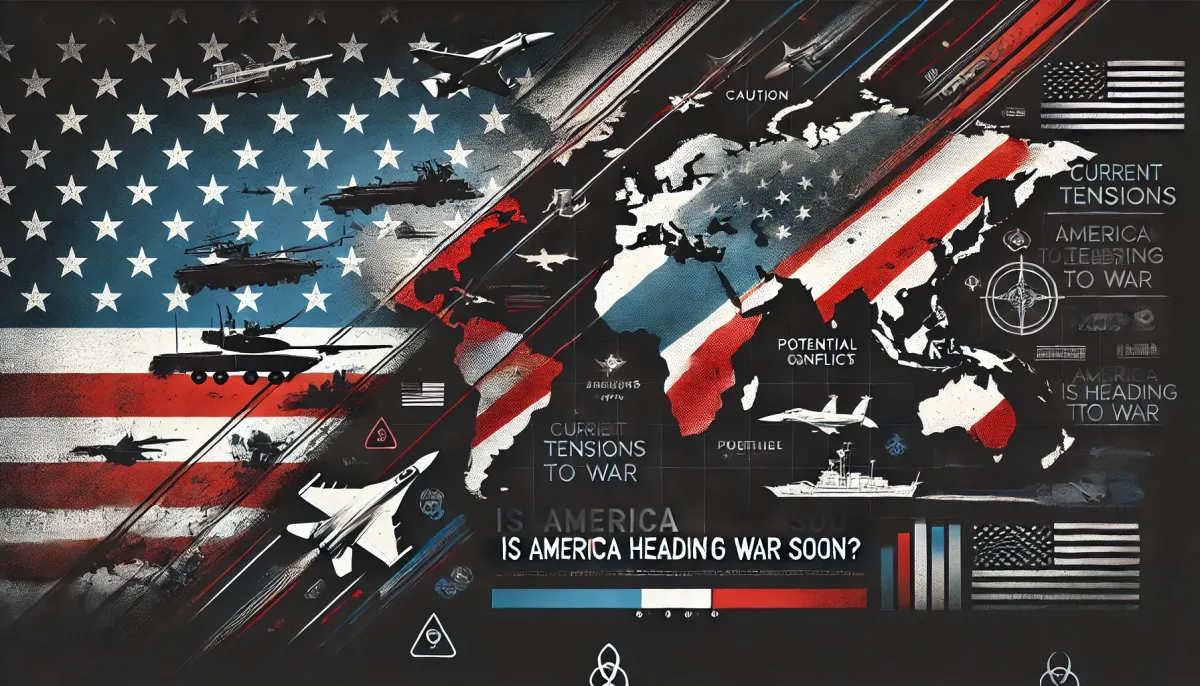Current Tensions: Is America Heading to War Soon?

In an era characterized by geopolitical instability and evolving global power dynamics, the question of whether America is on the brink of war has become a topic of increasing concern. As tensions escalate with major world powers such as China, Iran, Russia, and North Korea, it is imperative to assess the likelihood of these tensions culminating in open conflict. This analysis will delve into the complex relationships and potential flashpoints that could lead to war, as well as the predictions surrounding the year 2025.
The U.S.-China Relationship: A Delicate Balance

Economic Rivalry: Trade Wars and Technology Battles
The United States and China are locked in a multifaceted competition that spans economic, technological, and military domains. The trade war initiated in recent years has exacerbated tensions, with tariffs affecting billions in goods and impacting global markets. Beyond trade, the competition extends into technology, with both nations vying for dominance in critical areas such as artificial intelligence and 5G networks. This technological rivalry fuels further distrust, as each country perceives the other's advancements as a direct threat to its own national security.
Military Posturing in the Asia-Pacific
The military dynamics between the U.S. and China are equally complex. In the Asia-Pacific region, both nations continue to assert their influence, leading to frequent military encounters. The South China Sea remains a potential flashpoint, with China's militarization of disputed islands challenging international norms. Meanwhile, the U.S. conducts freedom of navigation operations to counteract Chinese claims, leading to a delicate dance of military posturing that could spiral into conflict if not carefully managed.
The Taiwan Question: A Trigger for Conflict?
Taiwan represents one of the most critical issues in U.S.-China relations. China's increasing pressure on Taiwan, coupled with the U.S.'s support for the island, creates a volatile situation. Any move towards Taiwanese independence or a miscalculated military action could potentially trigger a conflict. Both countries must navigate this sensitive issue with diplomatic tact to avoid escalation that could lead to a broader war.
Predictions for Conflict: Managing Competition
While the risk of an imminent war remains low, analysts warn that miscalculations or escalations over Taiwan or the South China Sea could lead to conflict. The question of whether America will go to war with China hinges on the ability of both nations to manage their competition without resorting to military confrontation. Continued dialogue and mutual understanding will be crucial in mitigating risks and preserving peace.
Iran: A Powder Keg in the Middle East

Nuclear Ambitions: The JCPOA and Beyond
Iran's nuclear program has been a longstanding concern for the United States and its allies. The U.S. withdrawal from the Joint Comprehensive Plan of Action (JCPOA) marked a significant turning point, leading to a series of escalations. Iran's uranium enrichment activities and potential nuclear capabilities pose a direct challenge to regional security, prompting fears of a nuclear arms race in the Middle East.
Regional Influence and Proxy Conflicts
Iran's influence extends beyond its nuclear ambitions, as it supports various proxy groups throughout the region. These groups, active in countries like Syria, Yemen, and Lebanon, contribute to regional instability and often find themselves in direct opposition to U.S. interests. This support complicates efforts to achieve peace and stability, as proxy conflicts can quickly escalate into larger confrontations.
Diplomatic Efforts and Sanctions
While diplomatic efforts to revive the JCPOA continue, severe sanctions imposed by the U.S. have crippled Iran's economy, increasing domestic pressure on its leadership. The interplay between diplomacy and sanctions will determine the path forward, as both sides weigh the benefits of negotiation against the risks of further escalation. A breakthrough in diplomatic efforts could prevent a military confrontation, but the path remains fraught with challenges.
Is Conflict Inevitable? Contingent on Diplomacy
While diplomatic efforts to revive the JCPOA continue, the potential for conflict remains. A military confrontation could arise if Iran accelerates its nuclear program or if there is a significant escalation in proxy conflicts involving U.S. allies. The question of whether America will go to war with Iran remains uncertain, contingent on diplomatic negotiations and regional stability. The outcome will depend on the willingness of both parties to engage in constructive dialogue.
Russia: A Resurgent Power
Strategic Competition: Eastern Europe Tensions
The U.S.-Russia relationship is fraught with challenges, including strategic competition in Eastern Europe. NATO's eastern expansion has been a point of contention for Russia, which views it as a direct threat to its sphere of influence. The situation in Ukraine, particularly the annexation of Crimea and ongoing conflict in the Donbas region, exemplifies the tensions that exist, as both sides engage in a strategic tug-of-war over influence in the region.
Cyber Warfare: The New Battleground
In addition to traditional military concerns, cyber warfare has emerged as a significant threat. Allegations of Russian interference in U.S. elections and cyber attacks on critical infrastructure highlight the evolving nature of conflict. This new battleground poses unique challenges, as it blurs the lines between war and peace, making it difficult to establish clear rules of engagement and accountability.
Information Operations and Propaganda
Beyond cyber attacks, Russia has been accused of engaging in information operations aimed at sowing discord within the U.S. These efforts include disinformation campaigns and propaganda designed to influence public opinion and undermine democratic institutions. The battle for narrative control is as crucial as traditional military engagements, highlighting the complexity of modern geopolitical conflicts.
Prospects for War: Managing Tensions
Despite these tensions, the likelihood of a direct military conflict between the U.S. and Russia remains low. However, the potential for proxy conflicts and cyber confrontations persists. The question of whether America will go to war with Russia hinges on the ability to manage these tensions through diplomatic and strategic means. Effective communication and confidence-building measures will be essential in reducing the risk of unintended escalations.
North Korea: The Unpredictable Threat

Nuclear Provocations: The Missile Menace
North Korea's nuclear ambitions and its provocative missile tests remain a significant concern for the United States. Each test serves as a reminder of the regime's capabilities and its willingness to defy international norms. These provocations strain diplomatic relations and increase regional tensions, as neighboring countries and the U.S. must continuously assess the threat posed by North Korea's arsenal.
Diplomatic Challenges: A History of Inconsistency
While diplomatic efforts have been made, progress has been inconsistent, and North Korea's unpredictability poses a constant challenge. Past negotiations have yielded mixed results, with agreements often falling apart due to mutual distrust and unmet expectations. The challenge lies in crafting a diplomatic strategy that effectively addresses North Korea's security concerns while ensuring denuclearization.
Regional Dynamics and Alliances
The situation in North Korea is further complicated by regional dynamics and alliances. China, as a key ally of North Korea, plays a pivotal role in influencing the regime's behavior. The U.S. must navigate its relationship with China while coordinating with allies such as South Korea and Japan to present a united front. This intricate web of alliances and rivalries adds layers of complexity to the already challenging task of achieving peace.
The Path to Peace or Conflict: Contingent on Leadership
The potential for conflict with North Korea is largely dependent on the actions of its leadership and the effectiveness of diplomatic negotiations. While the risk of war is not negligible, ongoing diplomatic efforts aim to mitigate this threat. The question of whether America will go to war with North Korea remains open, contingent on the success of these efforts. Constructive engagement and a commitment to dialogue will be key to preventing escalation.
War Predictions for 2025
Analyzing Trends: Technological and Political Shifts
As the world approaches 2025, several trends and scenarios could influence the likelihood of war involving the United States. The ongoing technological arms race, with advancements in artificial intelligence, cyber capabilities, and autonomous weapons, could alter the landscape of conflict. Political shifts, including changes in leadership and domestic priorities, also play a significant role in shaping foreign policy and military strategy.
Scenarios and Risk Assessment
Experts assess a range of scenarios that could lead to conflict, from accidental military encounters to deliberate acts of aggression. The interplay of regional disputes, economic competition, and ideological differences creates a complex risk landscape. Understanding these scenarios is crucial for policymakers as they develop strategies to prevent conflict and promote stability.
Expert Opinions: Divergent Forecasts
Analysts offer varying predictions for 2025, with some foreseeing increased geopolitical tensions and others highlighting opportunities for diplomatic resolutions. The potential for conflict will depend on the ability of global leaders to navigate these challenges and prioritize diplomacy over aggression. While some experts remain pessimistic, others point to historical precedents where diplomacy has successfully averted war.
The Role of Diplomacy in Shaping the Future
Diplomacy will play a pivotal role in shaping the geopolitical landscape in 2025. The ability to engage in meaningful dialogue, build trust, and establish international norms will be critical in preventing conflict. As global leaders grapple with complex challenges, the emphasis on diplomacy over militarism will be crucial in ensuring a peaceful future.
Conclusion: Navigating Uncertain Waters
In conclusion, while the potential for conflict exists with major powers such as China, Iran, Russia, and North Korea, the likelihood of an imminent war involving the United States is not predetermined. The outcome will depend on the strategic decisions made by national leaders, the effectiveness of diplomatic efforts, and the ability to manage complex geopolitical challenges.
The Importance of Informed Policymaking
As the world stands at a crossroads, it is crucial for policymakers and citizens alike to remain informed and engaged in the pursuit of peace and stability. Understanding the nuances of international relations and the factors that drive conflict will enable better decision-making and risk management.
Proactive Measures to Prevent Conflict
Preventing unnecessary conflict requires proactive measures, including confidence-building initiatives, diplomatic engagement, and multilateral cooperation. By prioritizing dialogue and collaboration, nations can work towards resolving disputes without resorting to war.
The Path Forward: A Call for Global Cooperation
The question of whether America is heading to war soon remains a pressing concern, requiring careful consideration and proactive measures to prevent unnecessary conflict. Global cooperation and a commitment to peace are essential in navigating the challenges of the 21st century. The path forward lies in embracing diplomacy, fostering mutual understanding, and working collectively towards a more stable and peaceful world.
